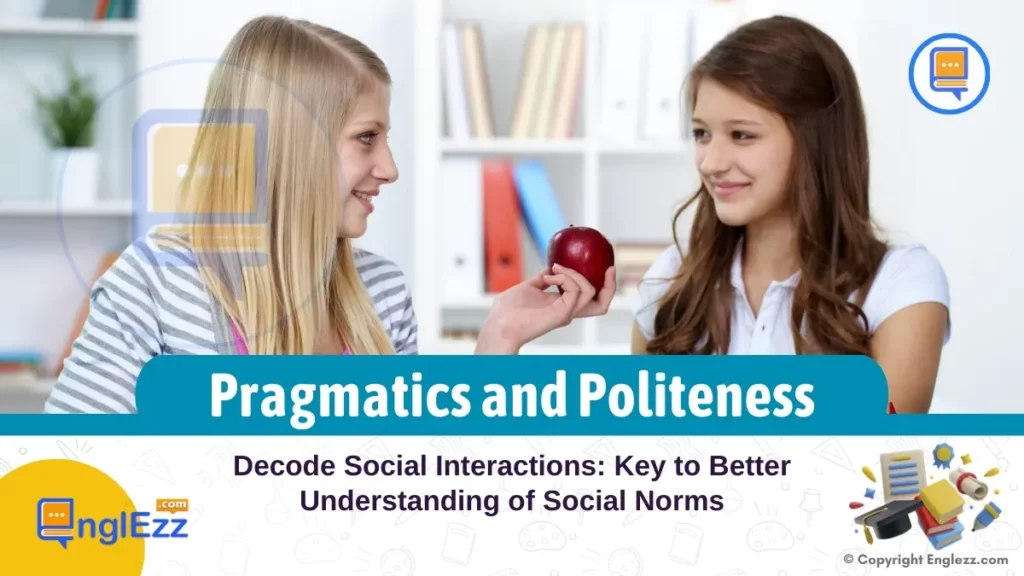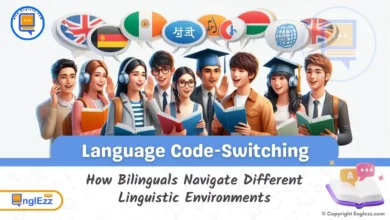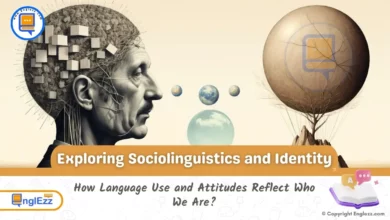Ever wondered why some conversations flow effortlessly while others end in confusion or conflict? The key lies in understanding the intricate dance of social interactions. Delving into the realms of pragmatics and politeness unveils a world where decoding social norms holds the golden ticket to fostering better communication and relationships with those around us.
Table of Contents
- Pragmatics and Politeness: Understanding Social Norms
- Understanding Pragmatics
- Importance of Politeness
- Nonverbal Communication Cues
- Empathy and Emotional Intelligence
- Conflict Resolution Techniques
- Technology’s Influence on Social Norms
- Enhancing Social Understanding Through Active Engagement
- FAQs on Pragmatics and Politeness:
- Q: How can I improve my pragmatic skills in daily communication?
- Q: What are some universal politeness strategies I can adopt?
- Q: How do cultural differences influence perceptions of politeness?
- Q: Why is empathy crucial for understanding social norms?
- Q: How can technology impact our interpretation of nonverbal cues?
Pragmatics and Politeness: Understanding Social Norms
In our daily interactions, unspoken nuances often wield more power than words alone. Pragmatics acts as a silent conductor, orchestrating how we interpret and respond to verbal cues within different contexts. This skill is akin to deciphering a code that unlocks the true intentions behind words, guiding us towards smoother interactions and deeper connections.
Meanwhile, politeness emerges as the velvet glove that softens societal edges, shaping how we navigate conversations with grace and respect, ultimately fostering harmony in our social tapestry. Together, these elements form a dynamic duo essential for mastering the art of understanding social norms and enriching our interpersonal encounters.

Are you ready to uncover the secrets hidden beneath everyday conversations? Join us on a journey through the realms of pragmatics and politeness as we unravel the mysteries of human interaction and pave the way for more profound connections and enriched relationships.
Understanding Pragmatics
In the realm of social interactions, pragmatics plays a vital role in how language is used beyond its literal meaning. Pragmatics can be defined as the study of language in use and how context influences interpretation. It focuses on understanding implied meanings, intentions behind words, and the impact of cultural norms on communication.
- For instance, a simple phrase like “Could you pass me the salt?” may seem like a request for salt, but in certain contexts or tone variations, it could also indicate annoyance or sarcasm.
The influence of pragmatic skills on daily communication is profound. Consider the scenario of apologizing when someone accidentally steps on your foot. Saying “It’s okay” might seem polite but depending on the context; it can imply that you are not bothered by personal space invasion or assertiveness regarding boundaries.
One of the most impactful ways to enhance your understanding of social norms and interactions is by actively listening to others. This means not just hearing words but truly comprehending their message and emotions. Practice techniques like paraphrasing what someone has said to ensure you’ve understood correctly. For instance, during a conversation, instead of immediately formulating a response in your mind, focus on fully absorbing what the other person is saying before contributing to the dialogue.
Understanding these nuances aids in smoother interactions and prevents misunderstandings. Context plays a pivotal role in deciphering pragmatic cues as what is considered appropriate or polite can vary widely across different social settings and cultures. Moreover, recognizing pragmatic principles leads to more effective communication strategies.
- For example, using indirect speech acts to express requests or suggestions respectfully without sounding commanding is crucial in professional environments where maintaining positive relationships is paramount.
Acknowledging the significance of pragmatics helps individuals navigate intricate social dynamics with precision and sensitivity, ultimately fostering meaningful connections built on clear understanding and mutual respect.
Importance of Politeness
Politeness acts as a fundamental building block in social interactions, shaping how individuals navigate relationships and convey respect. It goes beyond simple manners and etiquette; politeness reflects an individual’s awareness of social norms and their ability to adapt communication styles to suit diverse contexts.
Different cultures may have varying perceptions of politeness, leading to potential misunderstandings or clashes if these nuances are neglected. For instance, in some Eastern cultures, indirect language is used to maintain harmony and save face during conversations, contrasting with the more direct communication style prevalent in Western societies.
Within the realm of politeness strategies, scholars often categorize them into positive politeness (emphasizing closeness and camaraderie) and negative politeness (focusing on respect for others’ autonomy and boundaries). Understanding these strategies enables individuals to tailor their expressions based on the specific social setting they find themselves in.
- For example, when declining an invitation, employing positive politeness by expressing regret can soften the refusal’s impact without compromising sincerity.
Moreover, the influence of cultural backgrounds on interpretations of politeness cannot be overstated; what may seem polite in one culture could be perceived as overly formal or distant in another.
Cultural differences play a significant role in shaping perceptions of politeness. In Japanese culture, for instance, excessive compliments or exaggerated gestures may be viewed as insincere rather than polite. Conversely, a lack of formalities or directness can sometimes be interpreted as rudeness in contexts where such behavior is expected. By recognizing and respecting these cultural divergences in politeness norms, individuals demonstrate sensitivity to others’ backgrounds and foster more meaningful cross-cultural interactions.
Ultimately, mastering the art of politeness involves not only adhering to general societal expectations but also adapting one’s approach based on context-specific cues for effective communication that transcends linguistic barriers.
Nonverbal Communication Cues
Understanding nonverbal communication cues is pivotal in decoding social interactions as they often convey emotions and intentions that might not be expressed verbally. Body language, including posture, hand gestures, and facial expressions, plays a significant role in how our messages are perceived. For instance, crossed arms may signal defensiveness or disagreement, while maintaining eye contact can communicate attentiveness and interest. These subtle cues can either enhance or contradict the verbal message being delivered.
Facial expressions are another key component of nonverbal communication that provide valuable insights into a person’s emotional state. A smile can indicate warmth and friendliness, while furrowed brows might signify confusion or concern. Understanding these facial expressions can help individuals navigate conversations more effectively by adjusting their own responses accordingly. Moreover, gestures such as nodding in agreement or shaking one’s head to show disagreement serve as important nonverbal cues that contribute to the overall understanding of a dialogue.
Interpreting nonverbal cues alongside verbal communication is essential for grasping the complete meaning behind an interaction. For instance, if someone verbally agrees to a plan but exhibits hesitancy through their body language, there might be underlying reluctance or uncertainty about the decision. By paying attention to both verbal and nonverbal signals during conversations, individuals can cultivate a deeper understanding of others’ perspectives and foster clearer communication channels. Mastering the art of deciphering these cues empowers individuals to engage more authentically in social interactions and build stronger connections based on genuine understanding.
Empathy and Emotional Intelligence
Empathy and emotional intelligence play crucial roles in understanding social norms and decoding interactions effectively. Empathy involves the ability to understand and share the feelings of others, allowing individuals to connect on a deeper level and navigate social situations with sensitivity. By being empathetic, individuals can better interpret unspoken cues, respond appropriately, and build stronger relationships based on mutual understanding. Emotional intelligence complements empathy by aiding in regulating emotions, recognizing emotional cues in oneself and others, and using this awareness to guide behavior in social settings.
Building empathy is a cornerstone of meaningful communication and connection with others. Try to put yourself in someone else’s shoes regularly to understand their perspectives better. For example, if a colleague seems upset after a meeting, take a moment to consider what might have caused their distress, even if it’s not directly related to work issues. By practicing empathy consistently in various scenarios, you can significantly improve your social interactions and relationships over time.
To enhance empathy for improved social interactions, individuals can practice active listening, perspective-taking, and cultivating a genuine interest in understanding others’ perspectives. Engaging in activities that promote empathy, such as volunteering or engaging in meaningful conversations with diverse groups of people, can help individuals develop a more profound sense of empathy over time. Additionally, self-reflection and mindfulness practices can increase emotional intelligence, fostering a greater awareness of one’s own emotions and how they impact interactions with others.
Case studies offer compelling insights into the real-world impact of empathy on personal relationships. For example, a study showcasing how active listening and empathetic responses led to conflict resolution between coworkers illustrates how empathy can defuse tension and foster collaboration. In another scenario, a therapist demonstrating genuine empathy towards a client struggling with anxiety not only helped the client feel understood but also facilitated progress in therapy sessions. These cases underscore the transformative power of empathy in creating meaningful connections and resolving conflicts constructively.
Conflict Resolution Techniques
In the realm of social interactions, conflicts are inevitable but how we navigate and resolve them can significantly impact relationships. Effective conflict resolution strategies play a crucial role in maintaining healthy social dynamics. One key aspect of resolving conflicts is active listening. By attentively listening to the perspectives and feelings of others involved in the conflict, we demonstrate respect and show that their opinions matter. Active listening involves giving your full attention, processing what is being said without interrupting, and reflecting back to ensure understanding.
Furthermore, incorporating perspective-taking during conflicts can help broaden our understanding of different viewpoints. When engaging in a disagreement, considering the other person’s background, beliefs, and emotions can lead to more empathetic resolutions. By putting yourself in someone else’s shoes, you acknowledge their experiences and motivations which can foster mutual respect even amidst disagreements.

Collaborative problem-solving methods are another effective approach to resolving conflicts peacefully. Instead of approaching conflicts with a winner-takes-all mentality, working together towards finding common ground or compromises can lead to sustainable solutions. This method involves open communication, brainstorming ideas together, and focusing on shared goals rather than individual interests. Collaborative problem-solving not only resolves immediate conflicts but also strengthens relationships by promoting cooperation and understanding.
By integrating active listening, perspective-taking, and collaborative problem-solving into conflict resolution techniques during social interactions, individuals can navigate disagreements effectively while preserving relationships. These strategies encourage meaningful dialogue, empathy-driven resolutions, and cooperative processes that contribute to harmonious social environments where differences are acknowledged and respected.
Technology’s Influence on Social Norms
In today’s digitally connected world, technology has significantly reshaped traditional social norms and the way we interact with one another. The impact of digital platforms on communication styles and relationship dynamics cannot be overstated. With the rise of social media, instant messaging, and virtual meetings, individuals now have more avenues to engage with others but also face challenges in maintaining interpersonal skills in this digital age.
One prominent effect of technology on social norms is the shift towards more asynchronous forms of communication. Texting or emailing allows individuals to respond at their convenience, sometimes leading to delayed responses and misunderstandings due to the absence of immediate feedback typical in face-to-face interactions. This change can alter expectations regarding response times and acknowledgment standards in personal and professional settings.
Moreover, social media platforms have created new spaces for social interaction but have also introduced complexities in maintaining relationships. From interpreting emojis to managing online personas, individuals navigate a vast array of cues that influence how they are perceived by others. Additionally, the phenomenon of “ghosting,” where individuals abruptly cease communication without explanation, has become more prevalent through digital means, posing challenges to traditional etiquettes around closure in relationships.
Recognize and respect cultural differences in politeness norms and communication styles as you engage with individuals from diverse backgrounds. Learn about different customs and traditions to navigate social interactions more sensitively. For instance, in some cultures, direct eye contact may be a sign of respect, while in others, it could be perceived as confrontational. By being aware of these nuances, you can adapt your behavior accordingly and show genuine consideration for others’ cultural backgrounds.
Despite these challenges, technology offers benefits such as increasing accessibility and facilitating connections across geographical boundaries. Virtual meetings and online collaborations have enabled global engagement like never before. However, it remains crucial for individuals to adapt their interpersonal skills to effectively communicate in both physical and virtual spaces while being mindful of differences in etiquette influenced by technological mediums.
Enhancing Social Understanding Through Active Engagement
In a world where interactions are increasingly varied and complex, actively engaging in the decoding of social norms is pivotal for meaningful connections. Continuous learning and practice form the cornerstone of enhancing social understanding. By immersing oneself in different social contexts, individuals can sharpen their ability to decipher unspoken rules and signals that govern interactions. Just as a language evolves with usage, so too does our comprehension of the intricate dance of communication and etiquette.
Summarizing key takeaways on deciphering social interactions we find pragmatics at the heart of effective communication. Mastering pragmatic skills equips individuals with the ability to navigate nuances such as sarcasm or indirect requests within conversations. Politeness emerges as a crucial tool in upholding respect and consideration in engagements with others. Different cultures embrace contrasting politeness strategies; for example, while directness may be appreciated in Western societies, Eastern cultures often value more subtle forms of address.
Understanding nonverbal cues acts as a powerful complement to verbal exchanges. An arched eyebrow or a slight shift in posture can sometimes convey more than words themselves. Developing empathy plays a significant role in fostering connection and improving social dynamics. By putting oneself in another’s shoes, misunderstandings can be avoided, leading to more harmonious relationships even amid conflicting views or opinions. Embracing conflict resolution techniques paves the way for constructive dialogue and mutual understanding, fostering growth rather than discord.
As technology continues its pervasive presence in modern life, adapting communication styles becomes paramount. Digital platforms offer both challenges and benefits for maintaining interpersonal skills; navigating these changes requires agility and adaptability. In essence, by combining knowledge of pragmatics, politeness, nonverbal cues, empathy, conflict resolution strategies, and a willingness to evolve alongside technological advancements, individuals can unravel the intricacies of social norms – forging stronger connections built on understanding and mutual respect.
FAQs on Pragmatics and Politeness:
Q: How can I improve my pragmatic skills in daily communication?
A: Practicing active listening and observing contextual cues can significantly enhance your pragmatic skills. Engaging in conversations with diverse groups of people also helps in understanding varied speech patterns.
Q: What are some universal politeness strategies I can adopt?
A: Simple acts like saying “please” and “thank you,” maintaining eye contact during conversations, and showing genuine interest in others’ perspectives are universally appreciated polite behaviors.
Q: How do cultural differences influence perceptions of politeness?
A: Cultural norms play a significant role in shaping what is considered polite or rude. It’s important to be mindful of cultural sensitivities when engaging with individuals from different backgrounds.
A: Empathy allows individuals to connect emotionally with others, perceive situations from different viewpoints, and respond sensitively to varying feelings and needs – all essential elements in comprehending social norms.
Q: How can technology impact our interpretation of nonverbal cues?
A: Technology-mediated communication may limit our ability to pick up on subtle nonverbal cues like tone of voice or physical gestures. It’s necessary to balance digital interactions with face-to-face engagements for a holistic understanding of social dynamics.









Pragmatics and politeness reveal the art of social interaction. Delve into how understanding these concepts can improve your communication skills!